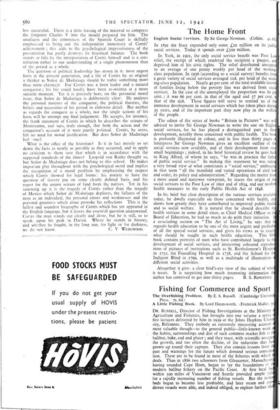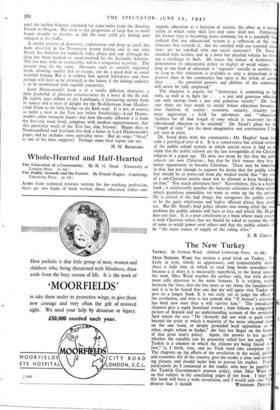Fishing for Commerce and Sport
A Little Fishing Book. By Lord Harmsworth. (Frederick Muller. 5
DR. RUSSELL, Director of Fishing Investigations at the Ministry Agriculture and Fisheries, has brought into one vo:ume a series five lectures delivered by him in 1939 at the Johns Hopkins Unive sity, Baltimore. They embody an extremely interesting account most valuable though—to the general public—little-known work the habits, surroundings and diet of such common market fish as t halibut, hake, cod and plaice ; and they trace, with scientific accuca the growth, and too often the decline, of the industries that ha grown up round their capture. They also contain lessons from past and warnings for the future which demand serious conside don. These are to be found in most of the fisheries with which deals. Thus in 1886 two schooners from Gloucester, Massachuset having rounded Cape Horn, began to lay the foundations of modern halibut fishery on the Pacific Coast. At first local within Soo miles of Vancouver and Seattle provided ample yid
for a rapidly increasing number of fishing vessels. But the insho
beds began to become less profitable, and later steam and Pe Macciirfield driven vessels were able, and indeed obliged, to explore farther afi
until the halibut fisheries extended for 2,000 miles from the Aleutian Islands to Oregon. But even so the proportion of large fish to small began steadily to decline, as did the total yield per fishing unit engaged in the traffic.
A similar process of discovery, exploitation and drop in catch has been observed in the Norwegian prawn fishing and in our own North Sea fisheries for haddock, hake, plaice and cod although the drop has been masked or supplemented by the Icelandic fisheries. The last war, with its restrictions, led to a temporary recovery. The present may do the same. Measures such as suitably regulated mesh, allowing smaller fish to escape, can do a good deal to avoid wasteful fishing. But it is evident that agreed limitations and close periods will have to be arranged in the future if the fishing industry is to be maintained with equable prosperity.
Lord Harmsworth's book is of a totally different character, a little pocketful of pleasant reminiscences by a lover of the fly rod. He rightly pays tribute to the Lambourn, a fascinating stream from its source and a river of delight for the fly-fisherman from Maiden- court Farm to the little bridge on the Bath road. It is not, of course, so noble a river as the Test just below Stockbridge—Lord Harms- worth's other favourite haunt—but how blessedly different it is from the five-star trout hotel, complete with modem appurtenances, that this particular reach of the Test has, alas, become. Happy days in Newfoundland and Scotland also find a home in Lord Harmsworth's pages, and he includes some agreeable verse. But do snipe " bleat," as one of his lines suggests? Perhaps some bird expert can say.
H. H. BASHFORD.



























 Previous page
Previous page